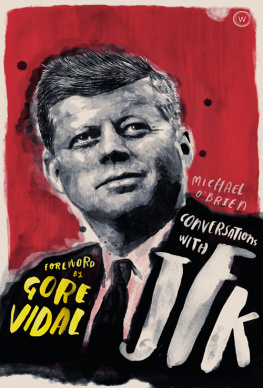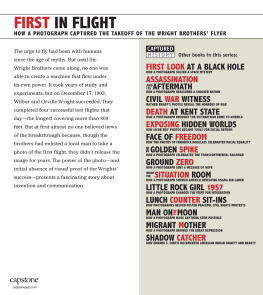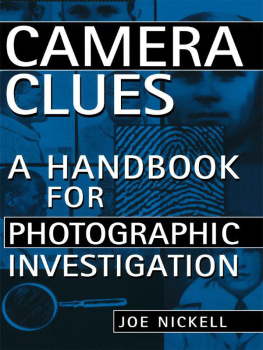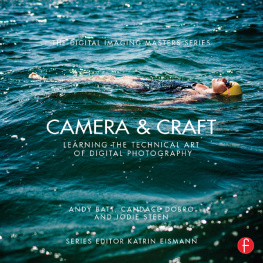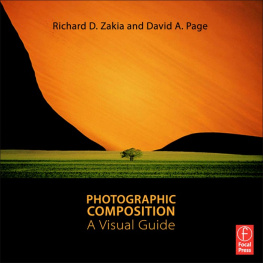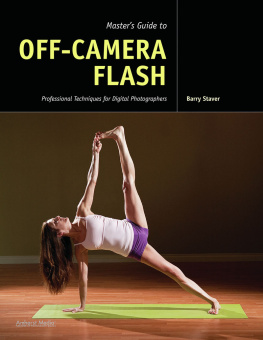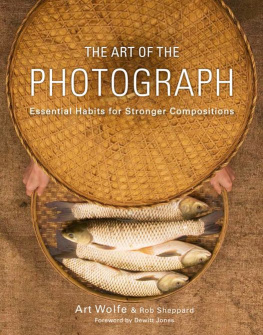Michael F. O'Brien & Norman Sibley
Copyright 1995 Davis Publications, Inc.
Worcester, Massachusetts U.S.A.

Student photograph by Gregory Conrad.
To the photography students of Seoul American High School, past, present and future.
No part of this work may be reproduced or transmitted in any form or by any means, electronic or mechanical, including photocopying and recording, or by any information storage or retrieval system without the prior written permission of the copyright owner, unless such copying is expressly permitted by federal copyright law. Davis is not authorized to grant permission for further uses of copyrighted selections or images reprinted in this text without the permission of their owners. Permission must be obtained from the individual copyright owners as identified herein. Address requests for permission to make copies of Davis material to Permissions, Davis Publications, Inc., 50 Portland Street, Worcester, MA 01608.
Editor: Claire Mowbray Golding Design: Greta D. Sibley Printed in the United States of America
Library of Congress Catalog Card Number: 93-74644
ISBN: 0-87192-283-5
1098 765
Cover: Student photograph by Leah Gendler.
Contents
7 Introduction
Part 1 Getting Started
11 Chapter 1 From Blurs to Big Business
History Photographic Careers
Part 2 Elements of Composition
35 Chapter 2 Tools
Manual or Automatic? The Camera, Inside & Out Exercises: Testing the Shutter & Aperture
Loading Film
51 Chapter 3 What is Composition?
Snapshots vs. Photographs Structure, Balance, Dynamics Exercises: Mat Frame Cropping
67 Chapter 4 Developing A Critical Eye
Critique Session Evaluating a Print Exercise: Sample Crit
83 Chapter 5 Point of Departure (f!6 at 1/125)
Starting Simply Doing it Right
87 Chapter 6 Line
Pattern, Structure, Direction Exercise: Pattern
95 Chapter 7 Texture
Expressing the "Feel" Exercise: Leaves
103 Chapter 8 Shape
Mass, Proportion & Relation Using Negative Space * Exercise: Circles & Ovals 113 Chapter 9 Light
Controlling Exposure Information & Mood Using a Light Meter Other Functions of Light Depth of Field * Exercise: Bracketing
129 Chapter 10 Motion
The Science of Blurs Stop and Co Exercise: Blurred Movement
137 Chapter 11 Perspective
Lenses Different Ways of Seeing A Point of View Exercise: A Point of View
Part 3 People, Places & Things: Exercises & Examples
151 Chapter 12 Things
Exercises: Bicycle Hubcaps & Taillights Eggs Object & Its Shadow Bottles & Classes Water
Old Things
167 Chapter 13 Places
Exercises: Landscape Architecture & Environment Neighborhoods Zoo/Farm Store Windows
* Construction Sites
181 Chapter 14 People
Exercises: Hands Elders Children Soft-Light Portrait Side-Lit Portrait Prop Portrait Detail Portrait Mood Portrait
197 Chapter 15 Putting It All Together
Exercises: Fairs Open Markets Rain Playgrounds Sports Events
209 Chapter 16 Breaking the Rules
Exercises: Night Monotone Silhouettes Grain and Diffusion Double Exposure Photo-Copy Photos Panel Panorama Text and Image
Appendixes |
| Appendix 1 Processing Processing Film Printing Manipulation |
| Appendix 2 Color From B&W to Color Technical Considerations |
| Appendix 3 Manipulation & Presentation Presentation * Manipulation |
| Appendix 4 Advanced Techniques Tools |
| Mat Frame (template) |
| Cropping Ls (template) |
| Bibliography |
| Glossary |
| Index |
| Acknowledgments |
Introduction
Photography is both an art and a science. As an art, it expresses a personal vision. As a science, it relies on technology. This double nature is not unique to photography. Every kind of creative expressionsuch as music, dance or painting has both a purely artistic side and a more scientific or tech-ological side as well. For example, paints are a kind of technology, and using them well involves a consid-rable amount of technical skill. The main difference between photogaphy and more traditional visual arts, such as painting, is the complexity of its technology.
In any of the arts, the first step toward excellence is mastering tech-ique learning to use a specific tech-ology skillfully and effectively. In photography, this means that you must learn to control the camera and darkroom equipment, rather than letting them control you.
No artist, however creative, can produce a masterpiece without a sound basis in technique. On the other hand, no amount of technical skill can make up for a lack of artistic vision. Both are essential. The goal of any artist is to use good technique creatively.
Simply speaking, a camera is a machine that produces a twodimensional (flat) copy of a threedimensional scene. The process by which this is done may seem like magic. (In fact, when cameras were first introduced, many people all over the world thought that they were magic.) Fundamentally, however, there's no magic in the camera. It's just a box with a hole in it. You supply the magic. When you, the photographer, use a camera creatively, it changes from a simple, mechanical machine into an artist's tool. Instead of making random copies of things, it begins to say something about them.
Here are some of the technical questions a photographer must answer for every photograph: How will the lighting affect the clarity and mood of the photograph? How fast should the shutter speed be? How large a lens opening should be used? What should be in focus? What belongs in the frame, and what doesn't? What lens should be used?
All these factors influence each other, and they all affect the final photograph. A photograph is "successful"in the technical sense when these factors all work well together and are combined with correct darkroom procedures. When a creative composition is added, the photograph becomes aesthetically successfully as well.
Eventually, you will learn how to control each of these factors to achieve the effect you want. But it will take time. As you may already know, it's often hard to keep all of them in mind every time you take a picture.
Fortunately, it is possible to begin more simply. This book is designed to help you do that. It begins with a brief summary of photography's past, present and future, including a discussion of photography careers. This is followed by an introduction to the camera itself. Chapters 3 and
4 provide a set of guidelines for composing and evaluating photographs. Chapter 5 explains a simple way to start producing correctly exposed photographs. As soon as you get that basic background behind you, you will begin your first photograph assignments. Chapters 6 through 11 deal with specific "elements" of photography. At the end of these chapters are exercises that will help you learn to recognize and use each element discussed.



